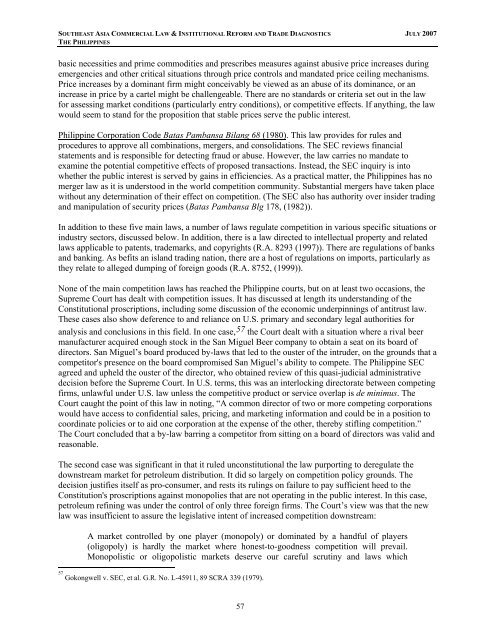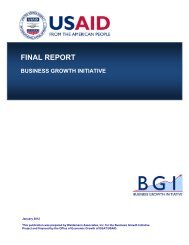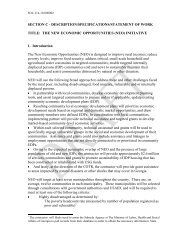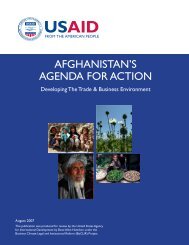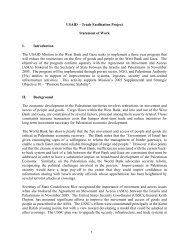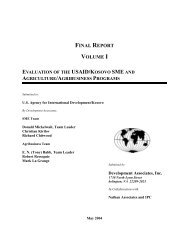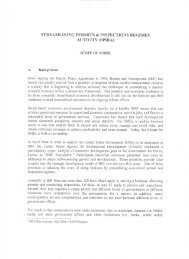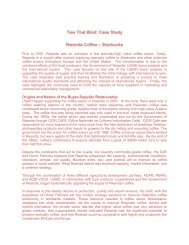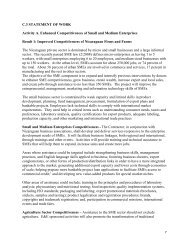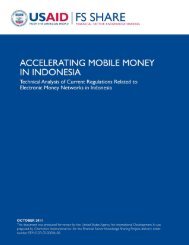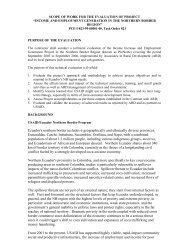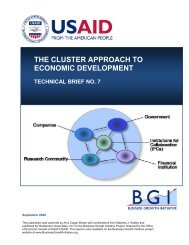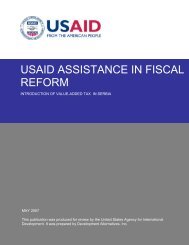The Philippines - Economic Growth - usaid
The Philippines - Economic Growth - usaid
The Philippines - Economic Growth - usaid
Create successful ePaper yourself
Turn your PDF publications into a flip-book with our unique Google optimized e-Paper software.
SOUTHEAST ASIA COMMERCIAL LAW & INSTITUTIONAL REFORM AND TRADE DIAGNOSTICS JULY 2007<br />
THE PHILIPPINES<br />
basic necessities and prime commodities and prescribes measures against abusive price increases during<br />
emergencies and other critical situations through price controls and mandated price ceiling mechanisms.<br />
Price increases by a dominant firm might conceivably be viewed as an abuse of its dominance, or an<br />
increase in price by a cartel might be challengeable. <strong>The</strong>re are no standards or criteria set out in the law<br />
for assessing market conditions (particularly entry conditions), or competitive effects. If anything, the law<br />
would seem to stand for the proposition that stable prices serve the public interest.<br />
Philippine Corporation Code Batas Pambansa Bilang 68 (1980). This law provides for rules and<br />
procedures to approve all combinations, mergers, and consolidations. <strong>The</strong> SEC reviews financial<br />
statements and is responsible for detecting fraud or abuse. However, the law carries no mandate to<br />
examine the potential competitive effects of proposed transactions. Instead, the SEC inquiry is into<br />
whether the public interest is served by gains in efficiencies. As a practical matter, the <strong>Philippines</strong> has no<br />
merger law as it is understood in the world competition community. Substantial mergers have taken place<br />
without any determination of their effect on competition. (<strong>The</strong> SEC also has authority over insider trading<br />
and manipulation of security prices (Batas Pambansa Blg 178, (1982)).<br />
In addition to these five main laws, a number of laws regulate competition in various specific situations or<br />
industry sectors, discussed below. In addition, there is a law directed to intellectual property and related<br />
laws applicable to patents, trademarks, and copyrights (R.A. 8293 (1997)). <strong>The</strong>re are regulations of banks<br />
and banking. As befits an island trading nation, there are a host of regulations on imports, particularly as<br />
they relate to alleged dumping of foreign goods (R.A. 8752, (1999)).<br />
None of the main competition laws has reached the Philippine courts, but on at least two occasions, the<br />
Supreme Court has dealt with competition issues. It has discussed at length its understanding of the<br />
Constitutional proscriptions, including some discussion of the economic underpinnings of antitrust law.<br />
<strong>The</strong>se cases also show deference to and reliance on U.S. primary and secondary legal authorities for<br />
analysis and conclusions in this field. In one case, 57 the Court dealt with a situation where a rival beer<br />
manufacturer acquired enough stock in the San Miguel Beer company to obtain a seat on its board of<br />
directors. San Miguel’s board produced by-laws that led to the ouster of the intruder, on the grounds that a<br />
competitor's presence on the board compromised San Miguel’s ability to compete. <strong>The</strong> Philippine SEC<br />
agreed and upheld the ouster of the director, who obtained review of this quasi-judicial administrative<br />
decision before the Supreme Court. In U.S. terms, this was an interlocking directorate between competing<br />
firms, unlawful under U.S. law unless the competitive product or service overlap is de minimus. <strong>The</strong><br />
Court caught the point of this law in noting, “A common director of two or more competing corporations<br />
would have access to confidential sales, pricing, and marketing information and could be in a position to<br />
coordinate policies or to aid one corporation at the expense of the other, thereby stifling competition.”<br />
<strong>The</strong> Court concluded that a by-law barring a competitor from sitting on a board of directors was valid and<br />
reasonable.<br />
<strong>The</strong> second case was significant in that it ruled unconstitutional the law purporting to deregulate the<br />
downstream market for petroleum distribution. It did so largely on competition policy grounds. <strong>The</strong><br />
decision justifies itself as pro-consumer, and rests its rulings on failure to pay sufficient heed to the<br />
Constitution's proscriptions against monopolies that are not operating in the public interest. In this case,<br />
petroleum refining was under the control of only three foreign firms. <strong>The</strong> Court’s view was that the new<br />
law was insufficient to assure the legislative intent of increased competition downstream:<br />
A market controlled by one player (monopoly) or dominated by a handful of players<br />
(oligopoly) is hardly the market where honest-to-goodness competition will prevail.<br />
Monopolistic or oligopolistic markets deserve our careful scrutiny and laws which<br />
57<br />
Gokongwell v. SEC, et al. G.R. No. L-45911, 89 SCRA 339 (1979).<br />
57


